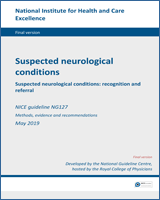NCBI Bookshelf. A service of the National Library of Medicine, National Institutes of Health.
This guideline covers the initial assessment of symptoms and signs that might indicate a neurological condition. It helps non-specialist healthcare professionals to identify people who should be offered referral for specialist investigation.
Contents
- Guideline committee members
- NGC technical team members
- Acknowledgements
- 1. Guideline summary
- 2. Introduction
- 3. Development of the guideline
- 4. Methods
- 4.1. Targeted engagement exercise with external experts:
- 4.2. Evidence reviews
- 4.3. Developing the review questions and outcomes
- 4.4. Searching for clinical evidence
- 4.5. Identifying and analysing clinical evidence
- 4.6. Identifying and analysing evidence of cost effectiveness
- 4.7. Developing recommendations
- 5. Part 1: Adults aged over 16 – signs, symptoms and investigative tests
- 5.1. Blackouts in adults
- 5.2. Dizziness and vertigo in adults
- 5.3. Facial pain, atraumatic
- 5.4. Gait unsteadiness
- 5.5. Handwriting difficulties
- 5.6. Headaches in adults
- 5.7. Limb or facial weakness in adults
- 5.8. Memory failure and cognitive deterioration in adults
- 5.9. Posture distortion in adults
- 5.10. Sensory symptoms including tingling or numbness in adults
- 5.11. Sleep disorders in adults
- 5.12. Smell or taste problems
- 5.13. Speech, swallowing and language problems in adults
- 5.14. Tics and involuntary movements in adults
- 5.15. Tremor in adults
- 6. Information and support
- 7. Part 2 – Children aged under 16 – signs and symptoms and investigative tests
- 7.1. Attention, concentration and memory problems
- 7.2. Blackouts and other paroxysmal events
- 7.3. Confusion, acute
- 7.4. Dizziness and vertigo in children
- 7.5. Headaches in children
- 7.6. Head shape or size abnormalities
- 7.7. Hypotonia (‘floppiness’)
- 7.8. Limb or facial weakness in children
- 7.9. Motor development delay and unsteadiness
- 7.10. Posture distortion in children
- 7.11. Sensory symptoms such as tingling or numbness in children
- 7.12. Sleep disorders in children
- 7.13. Speech problems in children
- 7.14. Squint
- 7.15. Tics and involuntary movements in children
- 7.16. Tremor in children
- 8. Reference list
- 9. Acronyms and abbreviations
- 10. Glossary
- Appendices
- Appendix A. Scope
- Appendix B. Declarations of interest
- Appendix C. Clinical review protocols
- Appendix D. Health economic review protocol
- Appendix E. Clinical study selection
- Appendix F. Health economic study selection
- Appendix G. Literature search strategies
- Appendix H. Clinical evidence tables
- Appendix I. Health economic evidence tables
- Appendix J. GRADE tables
- Appendix K. Forest plots
- Appendix L. Excluded clinical studies
- Appendix M. Excluded health economic studies
- Appendix N. Cost impact of neurological outpatient attendances
- Appendix O. Rationale for categorising symptoms
- Appendix P. Targeted engagement exercise
- Appendix Q. NICE technical team
- Appendix R. References
- Appendix S
Final version
Developed by the National Guideline Centre, hosted by the Royal College of Physicians
Disclaimer: The recommendations in this guideline represent the view of NICE, arrived at after careful consideration of the evidence available. When exercising their judgement, professionals are expected to take this guideline fully into account, alongside the individual needs, preferences and values of their patients or service users. The recommendations in this guideline are not mandatory and the guideline does not override the responsibility of healthcare professionals to make decisions appropriate to the circumstances of the individual patient, in consultation with the patient and, where appropriate, their carer or guardian.
Local commissioners and providers have a responsibility to enable the guideline to be applied when individual health professionals and their patients or service users wish to use it. They should do so in the context of local and national priorities for funding and developing services, and in light of their duties to have due regard to the need to eliminate unlawful discrimination, to advance equality of opportunity and to reduce health inequalities. Nothing in this guideline should be interpreted in a way that would be inconsistent with compliance with those duties.
NICE guidelines cover health and care in England. Decisions on how they apply in other UK countries are made by ministers in the Welsh Government, Scottish Government, and Northern Ireland Executive. All NICE guidance is subject to regular review and may be updated or withdrawn.
- NLM CatalogRelated NLM Catalog Entries
- Review Neuropathic Pain: The Pharmacological Management of Neuropathic Pain in Adults in Non-Specialist Settings[ 2010]Review Neuropathic Pain: The Pharmacological Management of Neuropathic Pain in Adults in Non-Specialist SettingsCentre for Clinical Practice at NICE (UK). 2010 Mar
- Review Anaphylaxis: assessment and referral after emergency treatment[ 2020]Review Anaphylaxis: assessment and referral after emergency treatment. 2020 Aug 24
- Review Tinnitus: assessment and management[ 2020]Review Tinnitus: assessment and management. 2020 Mar 11
- Synopsis of the National Institute for Health and Clinical Excellence Guideline for management of transient loss of consciousness.[Ann Intern Med. 2011]Synopsis of the National Institute for Health and Clinical Excellence Guideline for management of transient loss of consciousness.Cooper PN, Westby M, Pitcher DW, Bullock I. Ann Intern Med. 2011 Oct 18; 155(8):543-9. Epub 2011 Sep 19.
- Salicylate poisoning: an evidence-based consensus guideline for out-of-hospital management.[Clin Toxicol (Phila). 2007]Salicylate poisoning: an evidence-based consensus guideline for out-of-hospital management.Chyka PA, Erdman AR, Christianson G, Wax PM, Booze LL, Manoguerra AS, Caravati EM, Nelson LS, Olson KR, Cobaugh DJ, et al. Clin Toxicol (Phila). 2007; 45(2):95-131.
- Suspected neurological conditionsSuspected neurological conditions
- RecName: Full=RanBP2-like and GRIP domain-containing protein 3RecName: Full=RanBP2-like and GRIP domain-containing protein 3gi|325511349|sp|A6NKT7.2|RGPD3_HUMAProtein
Your browsing activity is empty.
Activity recording is turned off.
See more...
